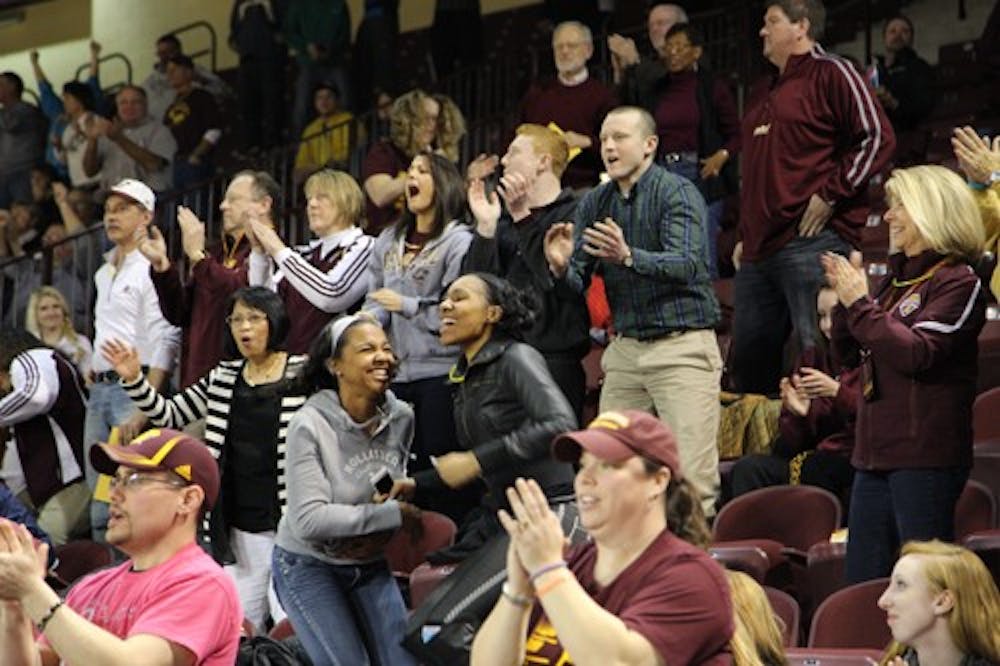Results of fan volume varies by sport, gives home teams advantage
Be it at home or on the road, the fans who attend athletic events can play a role in determining the outcome of a competition.
Each sport deals with blocking out crowd noise differently. For basketball, the athletes are right next to the crowd, creating potential for fans to get inside players' heads.
“(Fans) are sitting almost on the bench,” said Central Michigan men's basketball head coach Keno Davis. “When you’re that close, it’s easy for the athlete to be able to hear (a) fan. Whatever sport you are, the closer they are to the action, the more they have an impact on the game.”
In basketball, both teams are competing on the floor simultaneously, where as in gymnastics, there is only one athlete competing at any given moment, which can change the playing field. Fan noise and enthusiasm can have a direct impact on athletes trying to focus.
“I don’t have any problem with, at a football game, the fans (waving their arms) when somebody’s going to kick a field goal, because it’s not like you’ve never seen that before,” said gymnastics head coach Jerry Reighard. “But how do you train for someone making a slur that is intended to distract? I’m not, as a coach, going to yell obscenities at my team to get them ready for that possibility.”
Instances like Oklahoma State guard Marcus Smart's physical retaliation toward a verbal fan on Feb. 8 can put a stain on college athletics. Still, there are positive moments where fan enthusiasm has made a difference.
Some believe players alone decide the outcome, that they can choose to tune out the impact of the crowd. This is not entirely true, and Smart is exhibit A.
With the level of concentration gymnasts need, specifically on the balance beam, a distraction could have larger repercussions than in other sports. This is why Reighard approaches fans who are being disrespectful, which happened Feb. 23 at Illinois.
"I kind of had to quiet down a few guys that were in the front row,” Reighard said. “They were polite. My comment was, ‘Are you really going to dog us?’ or something like that. Then it became legitimate cheering and excitement for their team instead of dogmatic pointing, trying to intimidate.”
In a Feb. 15 gymnastics meet against Kent State, the crowd was in full force as the team was attempting to come back from nearly a point down in the late stages. The crowd erupted as sophomore Taylor Bolender’s 9.925 score was displayed.
Moments later, the gymnast from Kent State fell off the balance beam, bringing the Chippewas even closer to victory. While CMU lost the meet by .025 points, the crowd was able to mentally disturb the other team and almost gave the team the come-from-behind win.
Junior gymnast Kylie Fagan said part of their job is to be able to tune out fan noise.
“If some people let it affect them, it will affect them,” Fagan said. “But (fans) also help bring us up (and make) the judges think our team was even better than it was.”
In wrestling, the jeering is generally more accepted, perhaps due to the aggressive nature of the sport. Head coach Tom Borrelli said he is usually patient with obnoxious fans, especially because, in most cases, they are a part of the home crowd that attempts to help shake up the competition.
In mental sports like gymnastics and wrestling, getting inside the opponents' heads can be the extra push needed to win.
“I know we have some pretty rowdy fans,” Borrelli said. “I know we have some things that are said from the stands, but I think as long as there’s nothing racially motivated or ethnically motivated or derogatory (toward a) gender or something like that, then fans should enjoy themselves and get in people's (heads with) good-natured ribbing.”







